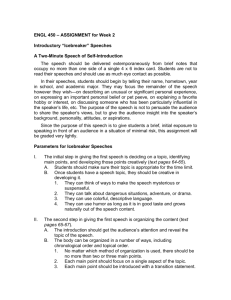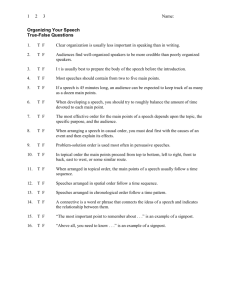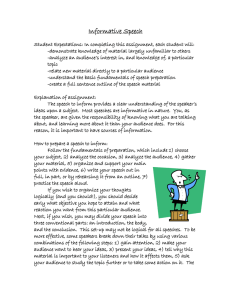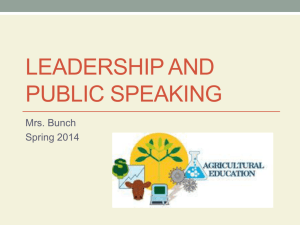Workshop presentation - Engadine West Public School
advertisement
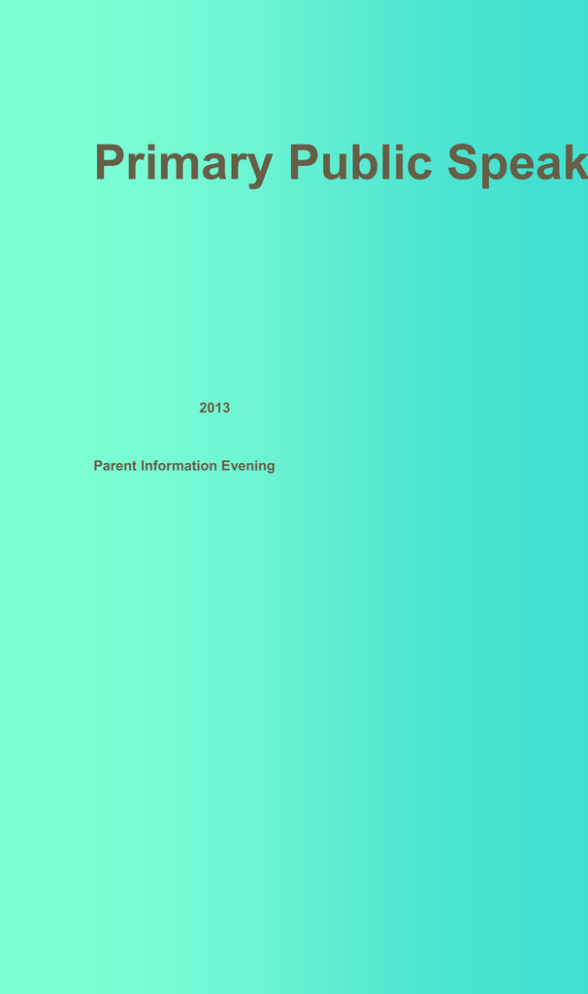
Primary Public Speak 2013 Parent Information Evening Public speaking can be the source of significant anxiety for children and for adults. Many adults can relate to the sweaty palms, rapid heartbeat, drycotton mouth, shaky knees, and nervous stomach associated with public speaking. Surveys of adult fears have ranked public speaking among the most feared experiences, in some instances above death, heights, and flying (Wallechinsky, Wallace, & Wallace). Public speaking can also be problematic for children. "Having to talk in front of my class" is in the school/ social stress fears components of the American Fear Survey Schedule for Children. How do we, as parents/caregivers help students overcome this fear? Early Stage 1 Stage statements By the end of Early Stage 1 students respond to a range of spoken written and multi-modal texts from familiar contexts. They communicate clearly and purposefully when engaging in pair, group or class discussions. They demonstrate an emerging awareness of how people use spoken language for different purposes. They deliver short presentations using familiar and learned vocabulary. they explore the way familiar texts are constructed and the features of these texts. Stage 1 Stage Statements By the end of stage 1 students communicate with a wide range of audiences on familiar and structured topics to achieve a variety of purposes. They interact effectively, adopting new communication skills and select vocabulary to enhance meaning in order to give confident presentations. They recognise that spoken language has a range of purposes and audiences and they use this knowledge when attempting to communicate effectively with others. Students create imaginative, informative and persuasive spoken texts drawing on their own experiences their imagination and ideas they have learned. Stage 2 Stage Statements By the end of stage 2 students communicate expressively and clearly with growing proficiency about ideas and information, in classroom, school and social situations for a range of purposes. They identify the effect of purpose, audience and culture on spoken texts and shape and present them accordingly. Stage 3 Stage Statements By the end of Stage 3 students communicate effectively, using considered language to entertain, inform and persuade audiences for an increasing range of purposes. They work productively and independently in pairs or groups to deliver effective presentations using various skills and strategies. Students collaborate with others to share and evaluate ideas and opinions and to develop different points of view. They express well-developed and well organised ideas about literary texts and respond constructively to different opinions. They demonstrate active listening behaviours in order to gather specific information and ideas, recognising and exploring how spoken and written language differ and how spoken language varies according to context. Students evaluate characteristic language features and organisational patterns of challenging spoken texts. Choosing the correct speaker for regional representation Focus on adjudication requirements which are underpinned by: ·Classroom/Home Preparation ·Presentation Skills ·Topic Choosing the correct speaker Classroom preparation · Explicit teacher and class input into skills and requirements based on adjudication criteria and good talking and listening. Teaching the skills. Explain the purpose. ·Opportunity to present in small groups first. It is good for students to critique each other in a positive way using specific criteria. That way students are focusing on skills needed and using the appropriate meta-language. It is also good for tho who lack confidence. Home preparation ·Encourage your child. Praise them for efforts. ·Assist your child to develop the skills of Public Speaking. ·Listen to your child's speech and give advise. Presentation ·A natural speaking presentation is more effective than a performance. It engages the audience whether young or old. Skills such as facial and vocal inflexions, eye contact and appropriate pauses can be teaching points. ·A relaxed stance and a natural presentation scores far higher than a stilted performance. What the child should be doin is taking the listener with them on a journey – engaging audience members in his/her speech so that the listener wants t hear more. ·Students must therefore, have ownership of their speech. Support may be given by parents.Speech must be age appropriate and relevant to the speaker. It is very obvious to an adjudicator when a student is passionate about a topic in realistic way. Choosing the correct speaker Topic ·These days all prepared speeches are good but it is the quality, structure and originality of the speech that scores. Cliched topics, no matter how good and how well presented will struggle to score highly on this criteria if a different original speech is presented. ·With the current level of competition, speeches must be sophisticated, of high interest but age appropriate. There shoul be a combination of fact and fiction – too many facts make it like a report and no facts make it like a narrative. Humour is always good when used appropriately and when speaker uses appropriate pauses. Some Useful Hints for Prepared Speeches · An interesting beginning to the speech should grab the attention of the audience and set the tone for the rest of the speech. ·You should have a strong and obvious close to the speech that ties all ideas together and leaves a lasting impression. ·There should be interesting ideas and appropriate language for the age and maturity of the child in the main body of the speech. Some facts, examples, quotes and opinions should be included here. ·A natural delivery without an abundance of hand gestures or dramatic movements is needed. ·A clear, confident voice that is easy for the audience to hear is appropriate. ·A smile and a real interest in the topic being delivered is a great hint. ·All students may use palm cards. They should be no bigger than the student’s hand. The student should refer to them for cues but NOT READ from them. The palm cards may have only a few words or pictures on them that give the speaker the cue for the speech. Make the cards to suit the needs of the student. ·The use of a mind map may help to start brainstorming to get the ideas flowing. Ideas can then be expanded upon to start building the speech. ·The speaker should not introduce him/herself at the beginning of the speech. He/she should not say “Good morning” etc. The opening statement should be the actual beginning of the speech. ·Do not finish the speech with words such as “the end” or even “thank you”. Make sure the final statement is strong and obvious. ·1. Opening with an unusual detail: (Manitoba, because of its cold climate, is not thought of as a great place to be a reptile. However, strangely enough it has the largest seasonal congregation of garter snakes in the world!) ·2. Opening with a strong statement: Cigarettes are the number one cause of lighter sales in Canada! ·3. Opening with a Quotation: Elbert Hubbard once said , "Truth is stronger than fiction." ·4. Opening with an Anecdote: An anecdote can provide an amusing and attention-getting opening if it is short and to the point. ·5. Opening with a Statistic or Fact: Sometimes a statistic or fact will add emphasis or interest to your topic. It may be wise to include the item's authoritative source. ·6. Opening with a Question. Have you ever considered how many books we'd read if it were not for television? ·7. Opening with an Exaggeration or Outrageous Statement. The whole world watched as the comet flew overhead. Manner, matter, method Manner (the presentation of the speech) • A speaker’s manner should be natural and conversational. • Exaggerated gestures, exaggerated use of voice, over-acting and the like should be discouraged in favour of a sincere down-to-earth manner. • With that in mind, it is still important that speakers develop their own individual style. Some speakers will come across more serious than others, some will be more entertaining and light-hearted. • Speakers must not use props, and should not act out scenes or sing no matter how good at it they are. • Eye contact with the audience should be maintained as much as possible. However, the best speeches are generally not learnt off by heart and robotically recited, but rather require the speaker to glance at his or her palm cards occasionally. Good speakers will occasionally stumble or say ‘um’. This is preferable to speeches which are at the one extreme entirely read or at the other over-rehearsed. The competition is very much a learning exercise for primary-aged speakers, and learners stumble from time to time • A speaker’s body language should again be natural and easy, which means hand gestures in moderation, a comfortable stance, and the occasional step. • Speakers’ voices should be relaxed and expressive without being exaggerated. Matter (the material in the speech) • The best speeches usually have a strong point of view and a clear direction. All good speeches have a purpose in mind. • The best speeches are balanced. This means a balance between personal perspective and a broader world-view, between rhetorical device and cold hard facts, and between humour and sincerity. A speech which is entirely personal is not a successful one, and nor is a speech which is essentially an information report. A simple tip would be to begin with a personal story and then broaden out to look at an issue in the community or the country, but remember that this won’t work for every speech. • Finally, good speeches are unique and striking. They should be original and catch the audience’s attention by presenting them with something they haven’t seen before. • In Stage 2 speakers should be encouraged to justify their opinion. • In Stage 3 their message should be profound and also justified. • Examples-speakers should support and prove their arguments and ideas with examples. An example in public speakin refers to people, places and events that have happened in the real world and that have been reported. Speakers should be taught the FIVE R’s that make a good example - Real - Reported - Recent - Reasonable - Relevant Method (the structure of a speech) • Speeches need to have a clear introduction, middle, and conclusion. • Good introductions are unique and give the audience a sense of the speaker’s theme without being boringly explicit. “My name is_____ and today I’m here to talk about_____” is a very dull beginning, as is anything equally pro forma. Speakers might try beginning with a question, an anecdote, or for more serious speeches, a bold and striking statement. • The middle of the speech should contain 3 or 4 separate, coherent ideas arranged so as to improve the flow of the speech, for example by moving from arguments on a personal scale to a look at a glob issue, or from a look at the past to where we are heading in the future. Each idea should be given a reasonable amoun time. A simple list of every idea related to the topic is not a useful way to structure this middle section. • Good conclusions are memorable, effective and original, avoiding pro forma clichés like “I hope you have enjoyed listening to my speech”. Speakers should also avoid thanking the audience and opt for a strong final statement of their message as their last words. • Finally, it’s important to time the speech properly. Roughly speaking, they should be wrapping up their final idea when first bell rings, and finishing off their conclusion when the two bells ring. Speakers should never reach the continuous b that comes one minute after the official speaking time has ended. In summary, while there’s no formula for writing the perfect speech, most good speeches have a purpose, are sincere, are balanced, and are original and striking. Ways to Structure Speeches ·Chronological - Order things according to time. ·Centred around questions - begin by posing questions about the topic and answer these as the speech unfolds ·Ascending order/Descending order - The most important or most difficult points first (or last) and then the other points in order. ·Pose a problem and use the main body of the speech to solve it. Pose the problem, explain its cause and sever and then present one or two possible solutions. ·PLG - Organise your speech by looking at the main idea from a Personal, Local and Global perspective. ·Spatial - Use a central idea and present a series of pictures or images about it ·Journey - Take the listener on an oral journey by mapping points or ideas. Hints for impromptu speeches ·Brainstorm the topic ·Suggested strategies can be: Mind Map PMI CoRT strategies 6 thinking hats ·Choose ideas from your brainstorming session and develop this further ·Encompass wider concepts (Local-National-Global) ·Your speech should have a clear message ·Decide your starting and finishing points (open and close strongly!) ·State the reason why you are speaking on the subject ·Speaking about personal experiences will give you courage and confidence ·Don't try to cover too much ·Be aware of bells and times. ·It is also wise to have an opinion at the conclusion or embedded into your speech. Structures and plans for an impromptu speech ·Chronological-order things according to time ·Question-centric-begin by posing questions about the topic and answer these as the speech unfold ·Ascending order-the most important or most difficult point first and then any remaining points to follow ·Problem solving-pose a problem and use the main body of the speech to solve it or, pose a problem, explain its cause and severity and then present one or t plausible solutions ·PLG-organise your speech by looking at the main idea from a personal, local and global perspective ·Journey-take the audience on an oral journey by mapping points or ideas ·The PRES PlanMake a Point with a confident opening line such as ‘I believe that...’ or ‘I think we should...’ State the Reason starting with words such as ‘This is because...’ or ‘The reason I say this is...’ Give an Example in the form of a story. A good lead in phrase might be ‘Just the other day...’ or ‘A good example of this was reported in the paper only recently.’ Include a Summary of your point. This reinforces your opening and gives a very clear and confident conclusion. You could start with ‘So you’ll see, that’s why I said...’ ·The Past Present Future Plan-this three-step plan has the speaker talking about what the subject was like years ago, the situation now and some specula on what it might be like in the future Step 1 ‘In the past...’ Step 2 ‘Today, the situation is very different...’ Step 3 ‘In the future, I believe we will see...’ Impromptus ·For impromptu speeches we need to have children who can think on multiple levels CONSISTENTLY. It is far more effective for a student to speak for 35 seconds validating opinions, using effective language and appropriat connectives than to ramble on with no substance for over a minute. The child should be within the time parameters but length is not always the best. This needs to be taught. Quality v quantity?? – just like writing. Aga use planning time effectively. ·Speeches need to be fluent, connected and express opinions but not be a prepared format to fit any topic. ·Skills will have been taught but students NEED to have the ability to think on their feet. Debating skills are very valuable. Look BEYOND the cute performer to the: ·DEPTH of the speech ·Ability to engage the audience by SPEAKING
